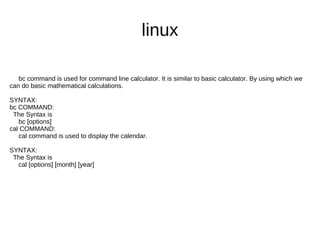Babitha.linux
- 1. linux bc command is used for command line calculator. It is similar to basic calculator. By using which we can do basic mathematical calculations. SYNTAX: bc COMMAND:
- 3. bc [options]
- 4. cal COMMAND:
- 5. cal command is used to display the calendar.
- 6. SYNTAX:
- 8. cal [options] [month] [year]
- 9. cat COMMAND:
- 10. cat linux command concatenates files and print it on the standard output.
- 11. SYNTAX:
- 12. The Syntax is
- 14. cd COMMAND:
- 15. cd command is used to change the directory.
- 16. SYNTAX:
- 17. The Syntax is
- 18. cd [directory | ~ | ./ | ../ | - ]
- 19. cp COMMAND:
- 20. cp command copy files from one location to another. If the destination is an existing file, then the file is overwritten; if the destination is an existing directory, the file is copied into the directory (the directory is not overwritten).
- 21. SYNTAX:
- 22. The Syntax is
- 23. cp [OPTIONS]... SOURCE DEST
- 24. date COMMAND: date command prints the date and time. SYNTAX: The Syntax is date [options] [+format] [date] echo COMMAND:
- 25. echo command prints the given input string to standard output.
- 26. SYNTAX:
- 27. The Syntax is
- 29. grep COMMAND:
- 30. grep command selects and prints the lines from a file which matches a given string or pattern.
- 31. SYNTAX:
- 32. The Syntax is
- 33. id COMMAND: id command prints the effective(current) and real userid(UID)s and groupid(GID)s. SYNTAX: The Syntax is id [options] last COMMAND:
- 34. last command is used to display the last logged in users list. Last logged in users informations are read from the file /var/log/wtmp.
- 35. SYNTAX:
- 36. The Syntax is
- 37. last [options]
- 38. lastlog COMMAND:
- 39. lastlog command is used to print the last login times for system accounts. Login information is read from the file /var/log/lastlog.
- 40. SYNTAX:
- 41. The Syntax is
- 43. ls COMMAND: ls command lists the files and directories under current working directory. SYNTAX: The Syntax is ls [OPTIONS]... [FILE] man COMMAND: man command which is short for manual, provides in depth information about the requested command (or) allows users to search for commands related to a particular keyword. SYNTAX: The Syntax is man commandname [options] mkdir COMMAND: mkdir command is used to create one or more directories. SYNTAX: The Syntax is mkdir [options] directories
- 44. mv COMMAND: mv command which is short for move. It is used to move/rename file from one directory to another. mv command is different from cp command as it completely removes the file from the source and moves to the directory specified, where cp command just copies the content from one file to another. SYNTAX: The Syntax is mv [-f] [-i] oldname newname pwd COMMAND: pwd - Print Working Directory. pwd command prints the full filename of the current working directory. SYNTAX: The Syntax is pwd [options] rm COMMAND:
- 45. rm linux command is used to remove/delete the file from the directory.
- 46. SYNTAX:
- 47. The Syntax is
- 48. rmdir COMMAND: rmdir command is used to delete/remove a directory and its subdirectories. SYNTAX: The Syntax is rmdir [options..] Directory sort COMMAND:
- 49. sort command is used to sort the lines in a text file.
- 50. SYNTAX:
- 51. The Syntax is
- 54. Shutdown - Turn off the computer immediately or at a specified time.
- 55. SYNTAX:
- 56. The Syntax is
- 57. /sbin/shutdown [-t sec] [-arkhncfFHP] time [warning-message]
- 58. who COMMAND: who command can list the names of users currently logged in, their terminal, the time they have been logged in, and the name of the host from which they have logged in. SYNTAX: The Syntax is who [options] [file] whois COMMAND: whois command lists the information about the domain owner of the given domain. SYNTAX: The Syntax is whois [option] query mkdir [OPTION] DIRECTORY Options mk
- 59. more - Allows file contents or piped output to be sent to the screen one page at a time
- 60. less - Opposite of the more command
- 61. clear - Clears the terminal screen.
- 62. cmp file1 file2 - Compares two files, reporting all discrepancies. Similar to the diff command, though the output format differs.
- 63. wc filename --- tells you how many lines, words, and characters there are in a file
- 64. whoami --- returns your username. Sounds useless, but isn't. You may need to find out who it is who forgot to log out somewhere, and make sure *you* have logged out.
- 65. cd ../samples The .. says to move up to the parent directory, in this case /users/jones , and then down to the sub-directory, samples . You can also use cd .. to back up from subdirectories level by level. The head Command To view the first ten lines in a file, use the head command. Syntax: head [ -count ] filename The tail Command To view the last ten lines in a file, use the tail command. Syntax: tail [-count] filename


![bc [options]](https://image.slidesharecdn.com/babitha-linux-100610011419-phpapp01/85/Babitha-linux-3-320.jpg)




![cal [options] [month] [year]](https://image.slidesharecdn.com/babitha-linux-100610011419-phpapp01/85/Babitha-linux-8-320.jpg)

